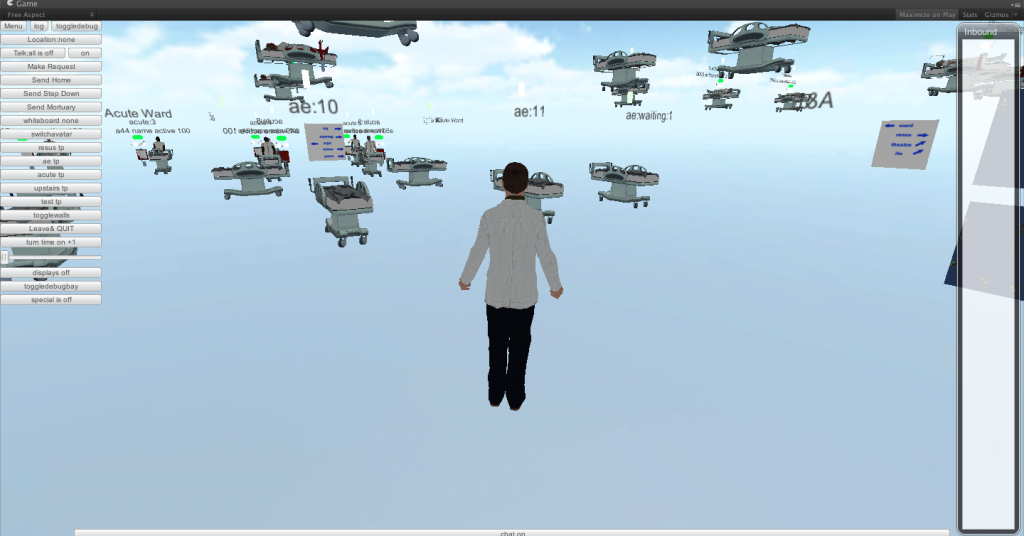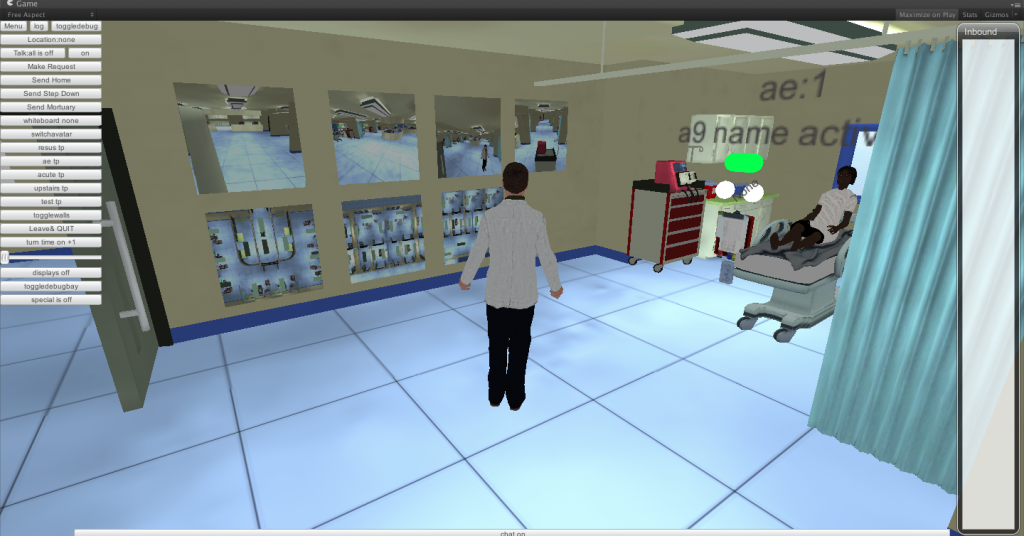I was going to write another reminiscing post about Wimbledon and the fantastic teamwork and effort that goes into delivering the tech there but I though I would be repeating myself.
However this year I can’t not mention Wimbledon for several reasons. The first is of course Andy Murray winning the whole Championship. The serendipity of it being 77 years since a brit won, combined with it being 7/7 that’s a lot of lucky numbers in a line 🙂
The predlets had got very into the tennis this year, but had forgot, or never been there to remember the 10 years I got to sit in the bunker there with the old company. They wanted to hear what it was like and some of the stories. One of them said “Dad, do you miss it?”. My honest reply was yes of course I miss the event and team of people that delivered it all. What I didn’t miss was the constant battles before the Championships that everyone who works there suffers. Wimbledon is a few weeks of intense work, generally in the corporate side of things it is not regarded as billable. There are some full time sports events guys and marketing people, but most of the UK team were willing volunteers and experts trying to carve time out of the normal work to do something high profile, risky and exciting. That meant anyone who was in control of your time felt they lost you for a few weeks. It also meant there were other people who may have felt jealousy or envy at the teamwork and comradeship the event still creates. Once the event is on people are pretty much locked in and doing something time dependent and high profile so have to be left alone. Once the event is done there can be some retribution, though at the same time people that have done the event are in high demand to be wheeled out in front of customers as a trophy expert. So the pattern is pretty much “you are not doing this… oh you are doing it…. well you shouldn’t…. can you please help us on this project with the expertise you have gained it will make the customer happy. Repeat.
The resilience of the guys and girls still managing to get there and do the job despite everything is as impressive as the effort itself. I hope the aftermath, with a british winner, is slightly softened though I suspect the any jealousy of the fact you were there when “it” happened may cause a noses to be put out of joint. 🙂
However, the thing this year that I was impressed about was that someone, somewhere had managed to get 3d printing into Wimbledon (something I didn’t manage in my time there though I did try 🙂 )
There are taking the data analytics and some social media feedback and 3d printing data souvenirs based on that “demand”.
I had somehow missed this as I was following more of the tennis matches this year than the press for the first time in a long while. So thanks to Andy Burns, who has managed to fight the wimbledon fight for some many years he may get his own statue, for changing his facebook profile picture to a 3d printed trophy which made me sit up and take notice.
Well done who ever managed to persuade someone to do something with this. A kindred spirit who I hope has had and will continue to have as much fun, sweat and tears at Wimbledon as many of us have had.
business
Training in a virtual hospital + zombies
It is not very often I get to write in much detail about some of the work that I do as often it is within other projects and not always for public consumption. My recent MMIS (Multidisciplinary Major Incident Simulator) work for Imperial College London and in particular for Dave Taylor is something I am able to talk about. I have know Dave for a long while through our early interactions in Second Life when i was at my previous company being a Metaverse Evangelist and he was at NPL. Since then we have worked together on a number of projects, along with the very talented artist and 3d Modeller Robin Winter. If you do a little digging you will find Robin has been a major builder of some of the most influential places in Second life.
Our brief was for this project was to create a training simulation to deal with a massive influx patients to an already nearly full hospital. The aim being several people running different areas of the hospital have to work together to make space and move patients around to deal with the influx of new patients. It is about the human cooperation and following protocol to reach as good an answer as possible. We also had a design principle/joke of “No Zombies”
Much of this sort of simulation happens around a desk at the moment, in a more role play D&D type of fashion. That sort of approach offers a lot of flexibility to change the scenario, to throw in new things. In moving to a n online virtual environment version of the same simulation activity we did not want to loose that flexibility.
Initially we prototyped the whole thing in Second Life. Robin built a two floor hospital and created the atmosphere and visual triggers that participants would expect in a real environment.
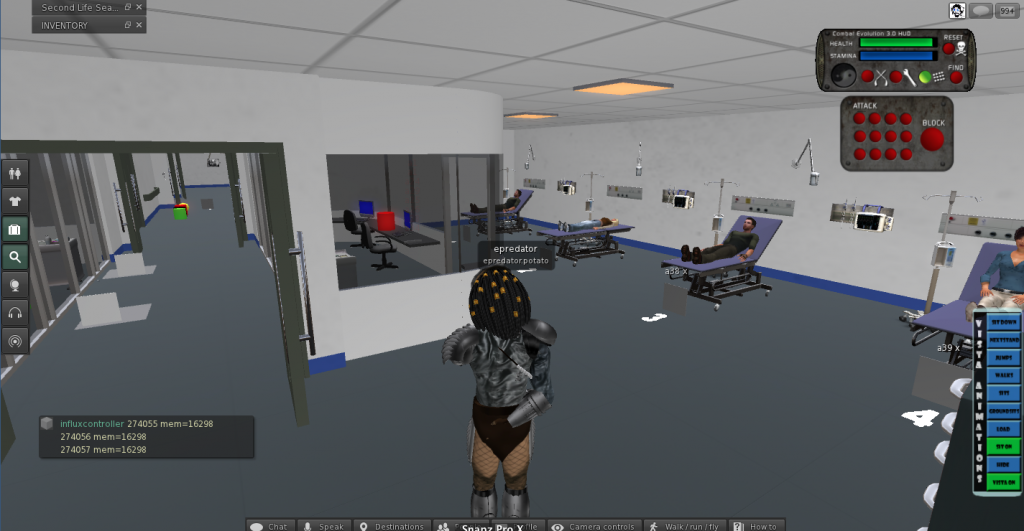
Note this already moves on from sitting around a table focussing on the task and starts to place it in context. However also something to note is that the environment and creation of it can become a distraction from the learning and training objective. It is a constant balance between real modelling, game style information and finding the right triggers to immerse people.
For me the challenge was how to manage an underlying data model of patients in beds in places, of inbound patients and a simple enough interface to allow bed management to be run by people in world. An added complication was that of specific timers and delays needing to be in place. Each patient may take more of less time to be moved depending on their current treatment. So you need to be able to request a patient is moved but you then may have to wait a while until the bed is free. Incoming patients to a bed also have a certain time to be examined and dealt with before they can then be possibly moved again.
A more traditional object orientated approach might be for each patient to hold their own data and timings but I decided to centralise the data model for simplicity. The master controller in world decided who needed to change where and sends a message to any interested party to do what they need to do. That meant the master controller held the data for the various timers on each patient and acted as the state machine for the patients.
In order to have complete flexibility of hospital layout too I made sure that each hospital bay was not a fixed point. This meant dynamically creating patients and beds and equipment at the correct point in space in world. I used the concept of a spawn point. Uniquely identified bay names placed as spawn points around the hospital meant we could add and removes bays and change the hospital layout without changing any code. Making this as data driven as possible. Multiple scenarios could then be defined with different bay layouts and hospital structure, with different types of patients and time pressures, again without changing code. The ultimate aim was to be able to generate a modular hospital based on the needs of the scenario. We stuck to the basics though, of a fixed environment (as it was easy to move walls and rooms manually in Second Life, with dynamic bays that rezzed things in place.
This meant I could actually build the entire thing in an abstract way on my own plot of land, also as a backup.
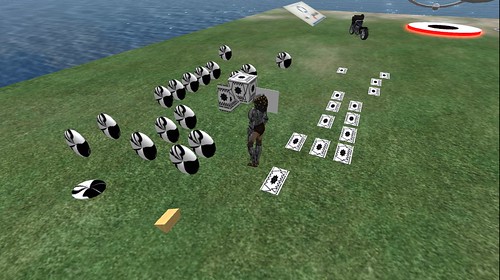
I love to use shapes to indicate the function of something in context. The controller is the box in this picture. The wedge shape is the data. They are close to one another physically. The torus are the various bays and beds. The flat planes represent the white board. They are grouped in order and in place. You can be in the code. Can think about object responsibility through shape and space. It may not work for everyone but it does for me. The controller has a lot of code in it that also has a more traditional structure. One day it would be nice to be able to see and organise that in a similar way.
This created a challenge in Second Life as there is only actually 64k of memory available to each script. Here I had a script dealing with a variable number of patients, around 50 or so. Each patient needed data for several timer states and some identification and description text. Timers in Second Life are a 1 per script sort of structure so instead I had to use a timer loop to update all the individual timers and check for timeouts on each patient. Making the code nice a readable with lots of helper functions proved to not be the ideal way forward. The overhead of tidyness was more bytes in the stack getting eaten up. So gradually the code was hacked back to being inline operations of common functions. I also had to initiate a lookup in a separate script object for the longer pieces of text, and ultimately yet another to match patients to models.
The prototype enabled the customers (doctors and surgeons) to role play the entire thing through and helped highlight some changes that we needed to make.
The most notable was that of indicating to people what was going on. The atmosphere of pressure of the situation is obviously key. Initially the arriving patients to the hospital were sent directly to the ward or zone that was indicated on the scenario configuration. This meant I had to write a way to find the next available / free bed in a zone. This also has to be generic enough to deal with however many beds have been defined in the dynamic hospital. Patients arrived, neatly assigned to various beds. Of course as a user of the system this was confusing. Who had arrived where. Teleporting patients into bays is not what normally happens. To try and help I added non real work indicators, lights over beds etc that meant a across a ward could show new patients that needed to be dealt with.
If a patient arrived automatically but there was no bed they were places on one of two beds in the corridor. A sort of visual priority queue. That was a good mechanism to indicate overload and pressure for the exercise. However we were left with the problem of what happened when that queue was full. The patients had become active and arrived in the simulation but had nowhere to go. This of course in game terms is a massive failure, so I treated it as such and held the patients in an invisible error ward but put out a big chat message saying this patient needed dealing with.
I felt this was too clunky to have to walk around the ward keeping an eye out so as I had a generic messaging system that told patients and beds where to be I was able to make more than one object respond to a state change. This led to a quick build of a notice board in the ward. At a glance red, green and yellow status on beds could be seen. Still I was not convinced this was the right place for that sort of game style pressure. It needed a different admissions process once that was controlled by the ward owners. They would need to be able to still say “yes bring them in to the next available bed (so my space finding code would still be work)” or direct a patient to a bed.
The overal bed management process once a patient was “in” the hospital
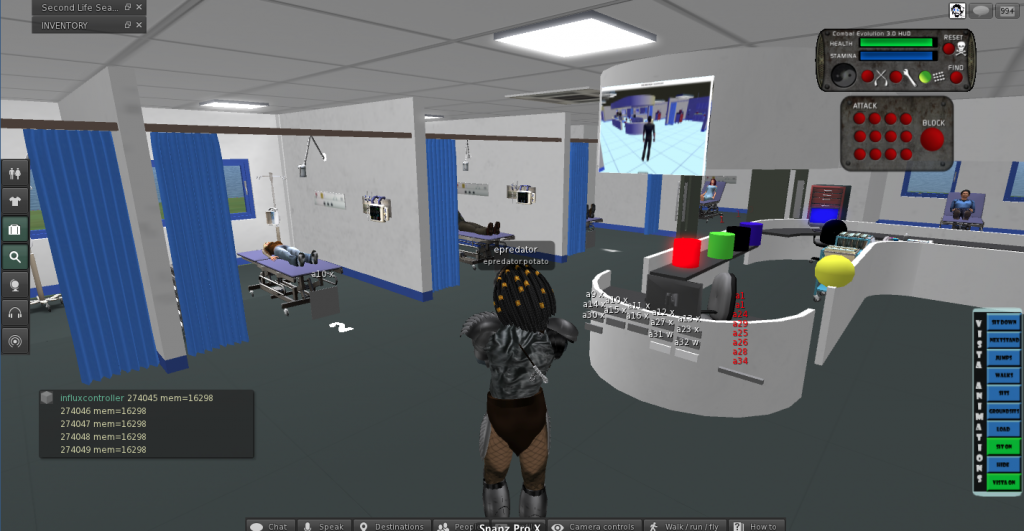
The prototype led to the build of the real thing. It was a natural path of migration to Unity3d as I knew we could efficiently build the same thing in a way we could then simply use web browsers to access the hospital. I also knew that using Exit Games Photon Server I could get client applications talking to one another in in synch. From a software engineering point of view I knew that in C# I could create the right data structures and underlying model to be able to replicate the Second Life version but in a much better code structure. It also meant I could initiate a lot more user interface elements more simply as this was a dedicated client for this application. HUD’s work in Second Life for many things but ultimately you are trying to not make things happen, you don’t want people building or moving things etc. In a fixed and dedicated unity client you can focus on the task. Of course Second Life already had a chat system and voice so there was clearly a lot of extra things to build in Unity, but there is more than one way to skin a virtual cat.
The basic hospital and patient bed spawning points connected via Photon in Unity was actually quite quick to put together, but as ever the devil is in the detail. Second Life is server based application that clients connect too. In Unity you tend to have one of the clients as a server, or you have each client responsible for something and let the others take a ghosted synchronisation. Or a mixture as I ended up with. Shared network code is complicated. Understanding who has control and responsibility for something, when it is distributed across multiple clients takes a bit of thought and attention.
The easiest one is the player character. All the Unity and Photon examples work pretty much the same way. Using the Photon Toolkit you can instantiate a Unity object on a client and have that client as the owner. You then have the a parameters or data that you want to synchronise defined in a fairly simple interface class. The code for objects has two modes that you cater for. The first is being owned and moved around, the other is being a ghosted object owned by someone else just receiving serialised messages about what to do. There are also RPC calls that can be made asking objects on other clients to do something. This is the basis for everything shared across clients.
For the hospital though I needed a large control structure that defined the state of all the patients and things that happened to them. It made sense to have the master controller built into the master client. In Unity and photon the player that initiates a game and allows connection of others is the master. Helpfully there are data properties you can query to find this sort of thing out. So you end up with lots of code that is “if master do x else do y”.
Whoever initiates the scenario then becomes the admin for these simulations. This became a helpful differentiation. I was able to provide some overseeing functions, some start, stop pause functions only to the admin. This was something that was a bit trickier in SL but just became a natural direction in Unity/Photon.
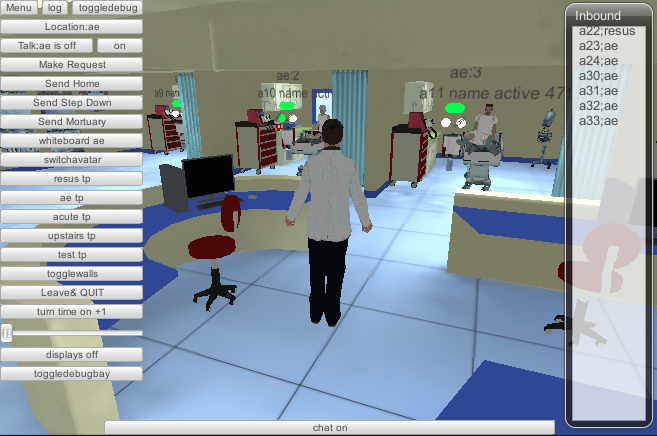
One of my favourite admin functions was to just turn off all the walls just for the admin. Every other client is able to still see the walls but the admin has super powers and can see what is going on everywhere.
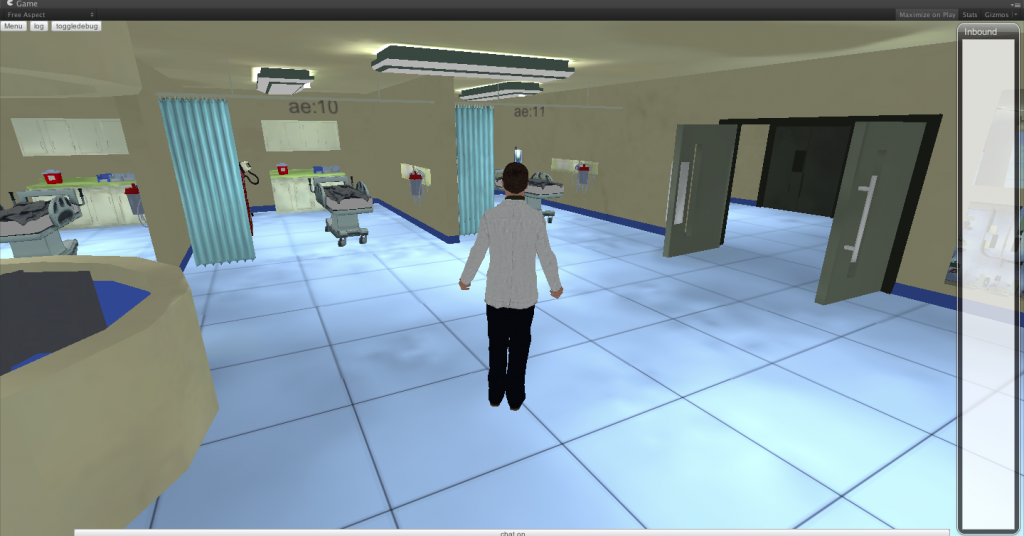
This is a harder concept for people to take in when they are used to Second Life or have a real world model in their minds. Each client can see or act on the data however it chooses. What you see in one place does not have to be an identical view to others. Sometimes that fact is used to cheat in games, removing collision detection or being able to see through walls. However here is it a useful feature.
This formed the start of an idea for some more non real world admin functions to help monitor what is going on such as cameras textures that let you see things elsewhere. As an example wards can be looked at as top down 2d or more like a cctv camera seeing in 3d. Ideally the admin is really detached from the process. They need to see the mechanics of how people interact, not always be restricted to the physical space. Participants however need to be restricted in what they can see and do in order to add the elements of stress and confusion that the simulation is aiming for.
Unity gave me a chance to redesign the patient arrival process. Patients did not just arrive in the bays but instead I put up a simple window of arrivals. Patient numbers and where there we supposed be be heading. This seemed to help, though a very simple technique, in a general awareness for all participants that things were happening. Suddenly 10-15 entries arriving in quick seemingly at the door to the hospital triggers more awareness than lights turned on in and around beds. The lights and indicators were still there as we still needed to show new patients and ones that were moving. When a patient was admitted to a bed the I put in the option to specify a bed or to just say next available one. In order to know where the patient had gone the observation phase is now additionally indicated by a group of staff around the patient. I had some grand plans using the full version of Unity Pro to use the path finding code to have non player character (NPC) staff dash towards the beds and to have people walking to and fro around the hospital for atmosphere. This turned out to be a bit to much of a performance hit for lower spec machines, though it is back on the wish list. It was fascinating seeing how the pathfinding operated. You are able to define buffer zones around walls and indicated what can be climbed or what needs to be avoided. You can then tell an object an end point and off it goes dynamically recalculating paths avoiding things and dealing with collision, giving doors enough room and if you do it right (or wrong) leaping over desks beds and patients to get to where they need to go 🙂 )
One of the biggest challenges was that of voice. Clearly people needed to communicate, that was the purpose of the exercise. I used a voice package that attempted to package messages across the network using photon. This was not spatial voice in the same way people were used to with Second Life. However I made some modifications as I already had roles for people in the simulation. If you were in charge of A&E I had to know that. So role selection became an extra feature not used in SL where it was implied. This meant I could alter the voice code to deal with channels. A&E could hear A&E. Also the admin was able to act as a tannoy and be heard by everyone. This also then started to double up as a phone system. A&E could call the Operating Theatre channel and request they take a patient. Initially this was a push to talk system. I made the mistake of changing it to an open mic. That meant every noise or sound made was constantly sent to every client, and the channel implementation meant the code chose to ignore things not meant for it. This turned out to be (obviously) massively swamp the Photon server when we had all out users online. So that needs a bit of work!
Another horrible gotcha was that I needed to log data. Who did what when was important for the research. As this was in Unity I was able to create those logging structures and their context. However because we were in a web browser I was not able to write to the file system. So a next best solution was to have a logging window for the admin that they could at least cut and paste all the log from. (This was to avoid having to set up another web server and send the logs to it over http as that was added overhead to the project to manage). I create the log data and a simple text window that all the data was pumped to. It scrolled and you could get an overview and also simply cut and paste. I worked out the size was not going to break any data limits or so I thought. However in practice this text window stopped showing anything after about a few thousand entries. Something I had not tested far enough. It turns out that text is treated the same as any other vertex based object and there are limits to the number of vertices and object can have. So it stopped being able to draw the text, even though lots of it was scrolled off screen. It meant the definition of the object had become too big. i.e. this isn’t like a web text window. It makes sense but it did catch me out as I was thinking it was “just text”.
An interesting twist was the generic noticeboard that gave an overview of the dynamic patients in the dynamic wards. This became a bigger requirement than the quick extra helper in Second Life. As a real hospital would have a whiteboard, with patient summary and various notes attached to it, then it made sense to build one. This meant that you would be able to take some notes about a patient, or indicate they needed looking at or had been seen. It sounds straight forward but the note taking turned out to be a little more complicated. Bear in mind this is a networked application multiple people can have the same noticeboard open, yet it is controlled by the master client. Typing in notes needed to be updated in the model and changes sent to others. Yes it turned out I was rewriting google docs ! I did not go quite that far but did have to indicate if someone had edited the things you were editing too.
We had some interesting things relating to the visuals too. Robin had made a set of patients or various sizes, shapes and gender. However with 50 patients or so, (as there can be any number defined) and each one described in text “a 75 year old lady” etc it meant it was very tricky to have all the variants that were going to be needed. I had taken the view that it would have been better to have generic morph style characters in the beds to avoid content bloat. The problem with “real” characters is they have to match the text (that’s editorial control), and also you need more than one of each type. If you have a ward full of 75 year old ladies and there are only 4 models it is a massive uncanny valley hit. The problem then balloons when you start building injuries like amputations into the equation. Very quickly something that is about bed management can become about details of a virtual patient. IN a fully integrated simulation of medical practice and hospital management that can happen, but the core of this project was the pressure of beds. i.e. in air traffic control terms we needed to land the planes, the type of plane was less important (though had a relevance still)
It is always easy to lose sight of the core learning or game objective with the details of what can be achieved in virtual environments. There is a time and cost to more content, to more code. However I think we managed to get a good balance with the release we have, and now can work on the tweaks to tidy it up and make it even better.
The application has also been of interest to schools. We had it on the Imperial College stand at the Bang education festival. I had to make an offline version of this. I was hoping to simply use Unity’s publish offline web version. This is supposed to remove the need to have any network connection or plugin validation. It never worked properly for me though. It always needed network. I am not sure if anyone else is having that problem, but don’t rely on it. That meant I then had to build standalone versions for mac and windows. Not a huge step but an extra set of targets to keep in line. I also had to hack the code a bit. Photon is good at doing “offline” and ignoring some of the elements but I was relying on a few things like how I generated the room name to help identify the scenario. In offline mode the room name is ignored and a generic name is put in place. Again quite understandable but cause me a a bit of offline rework that I probably could have avoided.
In order to make it a bit more accessible Dave wrote a new scenario with some funnier ailments. This is where were broke our base design principle and yes we put zombies in. I had the excellent Mixamo models and a free Gangnam style dance animation. Well it would have been silly not to put them in. So in the demos is the kids started to drift off the “special” button could get pushed and there they were.
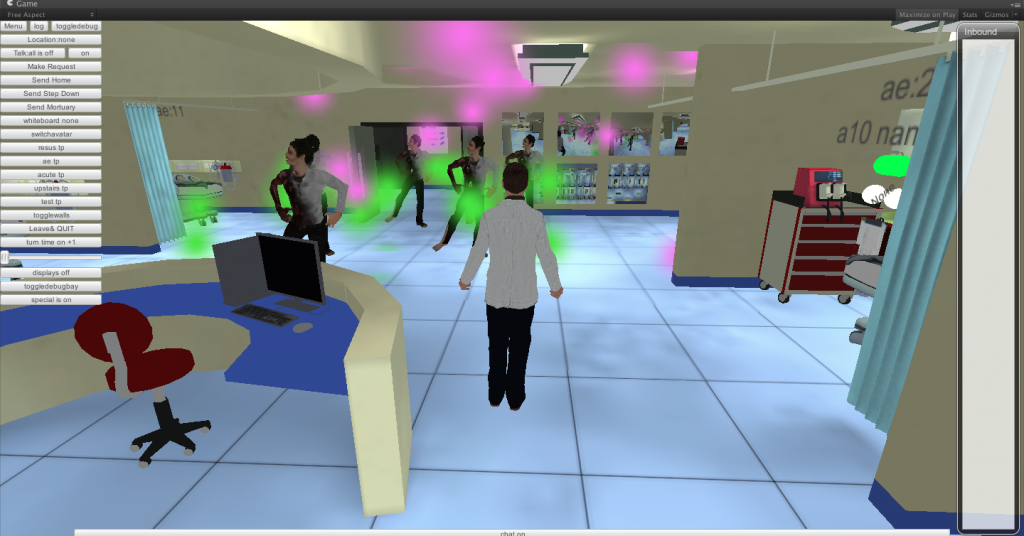
I have shared a bit of what it takes to build one of these environments. It has got easier, but that means the difficult things have hidden themselves elsewhere.
If you need to know more about this and similar projects application the official page for it is here
Obviously if you need something like this built, or talked about to people let me know 🙂
Virtual worlds getting a fashionable boost
I was honoured to be asked to write a piece on Virtual Worlds for this great online magazine Flush the Fashion. There is lots to see in the magazine but if you notice pages 98-101 I have explored the adoption path form Moshi Monsters and Binweevils to Opensim and alike via Minecraft. It looks great and they have done an awesome job 🙂 See what you think 🙂
Here is a direct link to the article
Also thank you for the opensim photos – The others images are all from my accounts.
and last but not least tidalblog
Advertising vs Chasing – Finding Customers and Investors
In all the Facebook IPO to and fro there has been a lot of discussion about advertising and whether it is viable as a way of keeping an advertising provider afloat and if it is worthwhile for those advertising in the first place.
That got me thinking about what I do to advertise myself and Feeding Edge and where that is going to go in the future.
Up until now most pieces of work have come via reputation and contacts, or responding to other shouts for help on social media. i.e. monitoring and going with the flow of serendipity. I much prefer this for the sort of work I do, as that after all is what this is all about. However not every person in every industry knows what I do do they?
So along with all the various startup pieces of work (of which there is a lot) I also try and keep my CV out there in case there is an interesting opportunity that fits well. That includes full time roles with companies too. I try and keep an open mind.

In the TV space I have, as I may have mentioned, attempted to get an Agent. That however seems even harder than just going to get a job. In a world full of celebrity, and willing first timers it seems that a moderate amount of experience with 3 series of TV doesn’t float that much interest from TV agent types. That pretty much is the same for headhunting agencies when they see my CV and the weird diversity of things I do to so I do understand 🙂
So, whilst my general business of consulting and developing I leave to a more ad hoc presence advertising, being here and there on line, helping as many people as possible and doing lots of conference speaking I decided to pay a little to list myself on a site for TV presenters. The “basic” account only lets you use text and mention you website and or agent, you have to pay more for links and video. However as I am a tech company I have my own site and links to the video so it seems odd to pay extra for hosting what is actually normal web. Also I am not sure how much traffic the listing gets as that is not easily verifiable. Still if you need me I am on GetPresenting.com I am not sure if that is going to work out, and it seemed odd to be paying to list as everything else, linkedin, twitter, Facebook , speakerfile (though not paying means no public profile!) and even the cv sites like Reed are all free as a basic account ( though in Reed I can’t just add a sharable link to my profile/CV it seems) . I figure that my activity on them and my willingness to share and engage is payment enough, after all that is the main business model. Being places online, lots of them, engaging in activity and experimenting with how that works all adds to my base of knowledge to share with people, and lets people also know who I am and what I do as a whole. This seems much more relevant than a single page CV, though I have that too!
So we shall see if that yields anything. It is actually easier to advertise as a TV presenter in Tech and games, or any other subject as it is an easily identifiable role. It is less easy to point out that much of what I do is production and research too to create the items. General TV presenting can be turn up and read the scripts and provide some pazazz and personality. I can do that too, as I like talking and enthusing.
As for the other stuff…. building, sharing, writing, exploring and helping are a very flexible “product” but a little harder to pin down, but as that is who I am am and what this business is “Taking a bite out of technology so you don’t have to” that’s how it has to be 🙂 I don’t think I will be taking out a Facebook advert to prop up the sure price just yet 🙂
I was described way back as a gun for hire, that makes it sound very simple doesn’t it!
Update – In a weird quirk of serendipity it seems I was writing this post as a lot of people I follow on Twitter are at The world employment conference 2012 check out the hashtag #ceitt2012, I guess that’s another conference I should have gone to speak at!
Pondering the world of work
The last few years I have had a chance to explore what it is to run your own company and act as a freelancer after many years in a “real” job in a corporate world. Every now and then my old brain clicks in and thinks how much easier it is to just do as you are told, or have the structure of someone else’s job to do.
At the same time I am left thinking about the freedom to act that doing your own thing allows. Such as suddenly finding myself doing TV work.
Then it flicks back around as I realise that the scramble for investors in startup endeavours and the amount of pro-bono or just plain free work that needs to be done is almost as much of a bind as a 9 to 5 job, without any of the certainty of a pay cheque. Each piece of work usually starts as a favour, which is again the same as in corporate life (“can you just take a look at this” tended to lead to most of the projects with the exception of virtual worlds which was actually me saying to myself “take a look at this” and it going ballistic as I kept sharing my ideas)
Then again I change tack as I realise the sheer diversity of things that I am able to do, setting up systems, coding in multiple languages, generating new ideas, presenting and sharing, TV presenting, enthusing and getting people on board, spotting trends and combining them, not fearing the new not forgetting the old, conferences, game technology and all the virtual world and 3d printing things really don’t fit well in any role anywhere. Being able to do a lot of things reasonably well, and pick up new things just makes more sense to go with the flow and see where things take me.
My wife very recently left one corporate environment for another, but a much better one. It involves a lot of commuting to and from London, but she is the Finance Director for a major part of that company, quite a step up from the corporate ladder rungs she was trying to climb in the old place.
That means that my odd time sliced life fits well now with the times the predlets need to be dropped off and picked up from school and the after school activities. So working as and whenever, mostly online on start-up activity fits really well.
I find that now I never really stop working, there is not definite start or end to the day or night, at the same time there is space to think and consider directions and ponder these odd combinations and extrapolations of technology and people.
I must admit I did admire the Reverse Job Application site and concept, having looked at a few sites and talked to a few recruiters the idea of switching it around, if you need me I am here, whilst getting on with whatever it is you do seems to make more sense.
The web, for me, is my CV, though I do have a perfectly normal document if anyone ever needs to see it. If anyone does feel they need my services, or wants to invest in some of the things I have not been able to share publicly yet (but more than willing to talk about if you are interested) then I am here. That includes any TV agents (who seem incredibly difficult to get on the books with even if you have done 3 series of TV, when you are an “expert” in a varied subject. You get more response applying for jobs than for getting representation it seems)
As a clue to the startup activity I have a gaming startup that has a rather forward thinking underlying basis of a form of genetic matching based on continuous social media and gaming activity that really uses everything else as an operating system, and is very much about people. We have an alpha, plus some extended designs ideas and it could change quite a few things when we get it in the right shape to go live. We have a good team just need more money and more developers to make it blossom.
Anyway, this rambling was brought on by having to do some very specific sys admin tasks that involved lots of magic incantations on various command lines on various cloud services that were so focussed and specific that I needed to fractally zoom back up into some sort of big picture again to remember who I am and what I do 🙂
Ok… time to cook tea, help the predlets do homework then sort out bedtime, then back to sorting out servers. See it is a very varied day isn’t it ?
Past the terrible twos – Feeding Edge is 3 years old
It is now, amazingly, 3 years since I started Feeding Edge ltd. Three years out of the relative cozy confines of corporate life. Note: That’s cozy in the sense that there is a structure, I am not suggesting anyone has it easy there. I spent 20 years in mainstream employment at IBM and I have now spent a fair amount of time acclimatizing and adjusting to a lack of structure. Oddly it was that structure and it’s positives and negatives that powers a degree of invention and skunkworks with many of the more sparky people in the company (or any company). Out in the rest of the world there are different combinations of structures there to work around, to adjust and flow with. They are just not always so obvious.

What has not changed is my attitude to helping people and to the technology, and just doing the right thing because it needs doing. If anything this has grown with a bit more freedom to explore and express ideas.
I do still suffer from the diversity of things that I get into with Feeding Edge. I was asked at a conference yesterday, after I presented, what I do with Feeding Edge. It is still the case that with this vessel I am “Taking a bite out of technology so you don’t have to”.
Most of my practical technical architecture, design, coding, presenting, funds raising, inventing etc is going towards an ever growing game related project as part of another startup. The ideas within that I still find amazing in their reach into social media and games and really it just needs a few more people focussed on the specifics of all the bits I ended up inventing. Which comes back to ongoing funding and buy-in to the project. So in many ways that is the same as many projects people have in corporate life, looking for backers, support etc.
It is reassuring to see things like Double Fine’s $2million raising of funding with crowdfunding on Kickstarter waking up a few business people and government departments this side of the pond. (Crowdfunding appears to be on a strange legal footing over here in the UK)
Another major strand for me this past year has of course been the Cool Stuff Collective TV show. Presenting, and working on creating the pieces with Archie Productions for CITV/ITV has given me a strand of content to take and talk about in all sorts of places. I have been very proud of the content and of the subjects we covered for kids and I now use those threads to try and inspire more kids in to tech at other events and conferences, whilst at the same time relaying the story of how we make that to adults. This also time informs them of some of the tech they may not have been aware of, but not in a head on way as it is about kids and a TV show.
So the question is how does this all move forward? Another year ahead.
I do occasionally look at job adverts, knowing pretty much that any job I took could get incredibly enthused with and maybe make a little bit of a difference. Not just tech ones either as I have developed a lot over the years in working with people, persuading, leading, mentoring and educating. All the technologies I share and talk about are about people and also about huge economic and social changes to come. Tech jobs are usually know version x or y, but there is so much more to be done.
I have yet to see a role that fits all the things I do with Feeding Edge, which makes me think either I have some sort of Unique Selling Point in diversity, or I should forget being a polymath and just focus on one thing.
It is not the case that I have no plan, but my plan is to carry on doing whatever it is I do. It really does not matter that it is hard to clarify and comparmentalize, because I am out in a world of infinite opportunity. Trying lots of things, threading many of those things together so they support one another, building tech, talking tech, living tech makes it much easier than being one particular thing or one particular role.
Of course all this comes at a cost. This approach, like starting brand new career strands such as TV presenting are back in the first rung of the ladder. That ladder being reputation, financial, etc. Stopping at any point, not doing a speaking engagement for instance, quickly erodes any building and levelling up that I may be doing in a particular industry, making new contacts etc. Conferences seldom pay directly, but the conversations lead to other things. The same as Tweeting and blogging are a “free” activity where you have to keep going, keep sharing to generate enough of a gravity well for someone to want to engage. “How do you find time to ….” well you just have to do it and weave it into life.
I often reflect as I hurtle from event to event that it is like being a touring rock band before the huge record deal. You play everywhere and anywhere that people will listen. Writing those killer tunes, practising the art. Which in the end is the most important thing. Though you dream of a stadium gig and a number one single.
So in the ups and downs of finance I have to say a huge thank you to my wife Jan (@elemming). She left IBM too, but only a few weeks ago and took up a fantastic opportunity based in London. It took a lot to leave after an even longer time than I spent there. It was worth it for the change and the impact she is able to have. Wherever you work you will start to be taken for granted eventually however good you are.
If you are reading this and think, we should get him in to talk to us, please do 🙂 If you are reading this and thinking there is nothing we need him to tell us and show us, well! you are exactly the sort of people that REALLY need me to come and help you.
See how that works? I do make life complicated for myself don’t I 🙂
Also please take a look at the new TV showreel 🙂 if you haven’t already.
People used to shun games now they ‘tion them
This title People used to shun games now they ‘tion them is something I tweeted to @TheKevinDent when he was riffing on the use of games being referred to as gamification by adding fication to common task was doing. I was joining in identifying that there is a rush towards games being acceptable, yet at the same time treated as a bandwagon. For some people the very idea that you can just slap a game in the process will solve their inadequacies of product, sales, management, HR policy etc continues to put games down as somehow an add on and not a integral part of life. The same happens with technology, anyone who is a techie will know how ever expert they get, however they diversify at some point they will be handed a broken phone or laptop by someone not skilled in the art and asked to fix it to prove themselves. Very few other professions (with the exception of being a comedian) are you asked to perform some party trick to prove you know what you are doing in this way. You don’t sit at a table with a banker and say oh go on just bank will you.
The commodity of games is being asked in some inappropriate places to “go on tell us a joke and make us laugh”. However, I am not totally against gamification as is does herald a moving on in understanding of something that was very much a quirky area for those of us who were early adopters.

This year is the 30th anniversary of the Commodore 64, I still have mine as you can see above. The Independent had a good article on Flight of the Commodore: How the iconic computer led to a golden age of geeks and to see things like attack of the mutant camels getting a mention once again certainly took me back to a magical time. Don’t get me wrong loading from a tape deck was a right pain, the games were simple yet elegant, but we did have that direct connection with the environment to be able to make new things. This, and the zx81 I had before shaped who I was to become and how my career, however bizarre, has evolved. Hence great fondness, and also a willingness to let another generation grow and learn from that.
There are some elements to what you might call gamification, that diverge from just adding badges to things. (I still maintain business is a game anyway, people use piles of money and positions on the corporate ladder to measure success or failure).
In many of my talks now I end up in this sort of territory and seems to boil down to the fact that games are not just an end product of a manufacturing process. In the c64 days people wrote games, we loaded them and played them, or we wrote our own. There was not the capacity to use an existing game as a platform for something else.
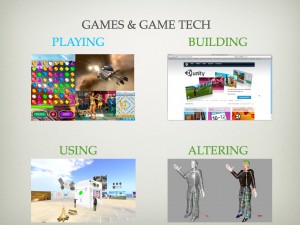
Playing games was the thing that people shunned. Play being regarded as a frivolous lack of work. That of course can still be the case but we know with the advances in the sort of games that exists that playing and rehearsing, experiencing things virtually all add to our human experience.
For the more serious minded, building games. It is strange that many computer scientists and software engineers still think that because the end product is colourful and things moves and lights flash that the level of engineering in games is not worthy. That is of course utter tosh. It is totally driven by the view of an end user and not liking the end product for whatever reason, usually few of exhibiting sub standard performance in front of someone skilled in the game. It is the path of building games that let us excite the next generation of software engineers. Kids play games and they DONT think they are a wast of time and pointless. i.e. they are the same as we were in the 80’s on our c64, “wow that’s cool I wish I could do that”
Luckily the world has also evolved to allow us to not just be either a player of a game or a builder of a game. Tools, games styles, application of game technology have provided all sorts of toolkits in games that let anyone create things, share things and make things happen. Some of these are just simple customisations, the sort that lend themselves to brand involvement (let me were my Nike tshirt in the game). Others are expressions of deeper creativity, painting cars in Forza4. There are even the much deeper technical challenges, building complex logic machines in Little Big Planet to create game levels. It is these elements that really look like the future of games in places where games would not normally tread, probably more so than badges and loyalty points. It is about deep engagement with ideas, brands, people etc across multiple places and platforms including the physical world. It is also very much about people being able to adjust build and mash together as they see fit.
It is Maker Culture
So it is good that the future for games is good, it is woven into society and will help us level up our kids if we think about it and use them wisely. (Oh and still enjoy a good frivolous play aswell!)
A concerned citizen of the web – SOPA? PIPA? – Blackout time
Firstly, I do not condone piracy, theft, unfair use of others work. However, I really am concerned that the gains we have made, and continue to make, in human communication online are going to be impacted by laws made in individual influential countries, like the US seeking to restrict some behaviour they regard as wrong.
There will be all sorts of political agendas at work with SOPA and PIPA in the US, but as we know country boundaries and country interests are eroded by the internet. Everything is local now. Passing laws, or attempting to that give well legally well represented organisations the power to block other “threatening” groups may seem to make sense in downloading movies, or music but the pattern does, and will apply to other areas. These laws will not stay in the areas they are intended. The vested interests of a few will have a wide reaching impact.
My personal experience in this is of the already draconian DMCA takedowns that can occur. Whilst officially working at a sports event I posted a video on youtube of the venue as part of a blog post. Somewhere one of the media partners had an intern trawling the internet for any references to the sports event and video of it. The rules being that no live play should be put on the web. In my video the venue was not even open. Yet the large company issued a DMCA takedown to google which caused the video to instantly be blocked. I did of course have the ability to try and get it back, this involved sending faxes, letters, emails etc to Youtube. It then required the other organisation to be bothered to acknowledge that. They were in the next door office, so I went and personally told them. However… the people spotting the infringements were not empowered to undo them. So it took weeks for the video to return. Now that example is just 1 simple mistake on 1 simple video but even it was a huge company with a lot of lawyers hitting one person without them. Imagine if that had led to the knock on of also crippling all my websites or my business, for however short period of time whilst an “appeal” occurred.
These control acts do nothing more than put everyone in jail cells so that no crimes are committed. It is not acceptable. Again I point out that this video incident did not matter, it was inconsequential against outing tyrants, helping the poor, improving the lives of disadvantaged people. Yet it was also not actually breaking any laws yet the law was applied. If it can happen here it can happen to anything. It will be abused, it will be misused and we will all suffer for it.
So like many much bigger sites this site will be going dark on 18th January 2012. The irony of self censoring will of course be lost on the passionate followers of this sort of restriction. We do though have do stand up against it.
There is more here in this video on what this is all about.
PROTECT IP / SOPA Breaks The Internet from Fight for the Future on Vimeo.
Car advertising the virtual way – Hyundai Veloster
Way back in the early days of the web I worked on, amongst other things, the Vauxhall car website. This was on an off for several years (we worked on multiple accounts in the early days). This was around 1997, a time when many of the things we wanted to do were not technically possible, or the web had not quite got where it needed to go. It was also at a time of CD-ROM experiences on magazines as opposed to downloads.You can see the sort of things that team was being done in 1996 here there were a number of advanced applications, traffic reports, screen savers and a touring car site, links to videos, later there were 360 quick times of the cars. It evolved in the next few years, around 98/99 into a personalised web site with login and buying capabilities and car configurations. These sorts of sites are common place now and so it is expected to be able to look at things online. Something we had all wanted to do was put the cars in a virtual experience, or game so you could drive them. At the time there were games like TOCA for touring cars so we could drive Vectra’s around, in the same livery as the touring car mini site we used. There was of course no link between the game, us and the car manufacturer, nor really the ability to make that happen. After all it was only a game, or only a website 😉
Now though the whorl has changed and this is a prime example. As a free download in the excellent Xbox driving experience Forza4 Hyundai has released a drivable, and explorable version of its new car the Veloster, both in road and race versions.
So this is really state of the art advertising. The car models are well known for their accuracy and quality in Forza. The ability to drive and experience the car inside and out, yet delivered for free makes this a very interesting experience. It doesn’t require the car manufacture to be a games developer, the game is a channel. Many people with Forza, probably everyone will at least download it as its free, new cars in game are exciting. Game challenges will pop up that are car specific too. Photos, videos etc will be created and distributed by fans online.
The physical and virtual world start to blend even more. It’s gaming but not gaming at the same time.
Nokia Lumia – Massive 3d projection
The launch of the new Nokia phone in a fight back against all the iphone/droids etc hit London with this very impressive and massive 3d projection on Millbank Towers in london. Which presumably has the right aspect ratio as a building to show the smartphone in a good light.
This on building projection is getting really popular and is really a giant augmented reality application that requires no headsets. Projecting onto the real world in any form makes it a good shared experience and the project technology is precise enough now to allow for the surfaces of building to be taken into account.
According to the youtube information “Each of the 120 metre high building’s 800 windows were covered with vinyl as 16 powerful projectors, stationed 300 metres away on the other side of the river, beamed 3D images onto the structure”
I hope the phone is as good as the advert!

